Biosolar Roof
Perhaps the most innovative aspect of greening at the Guardian is the attempt to marry green roof and solar photovoltaic technologies for the first time in our region, and on a building built in 1890 no less! Why? Because it makes sense. With the support of funding from the Capitol Region Watershed District these two technologies were installed along with a camera and monitoring equipment to document the project’s performance.
Green roofs can retain and manage stormwater, offer habitat to wildlife and aesthetic beauty to onlookers all while lowering summer air temperatures, the urban heat island effect and cooling costs. Solar photovoltaic systems operate more efficiently at cooler temperatures, which green roofs offer due to the cooling effects of evapotranspiration.
Onsite solar photovoltaic systems offer a carbon-free source of energy for the tenants of the building. A careful selection of plants coupled with solar can actually increase biodiversity in a green roof due to shading from the arrays. We are creating a self-reliant rooftop!
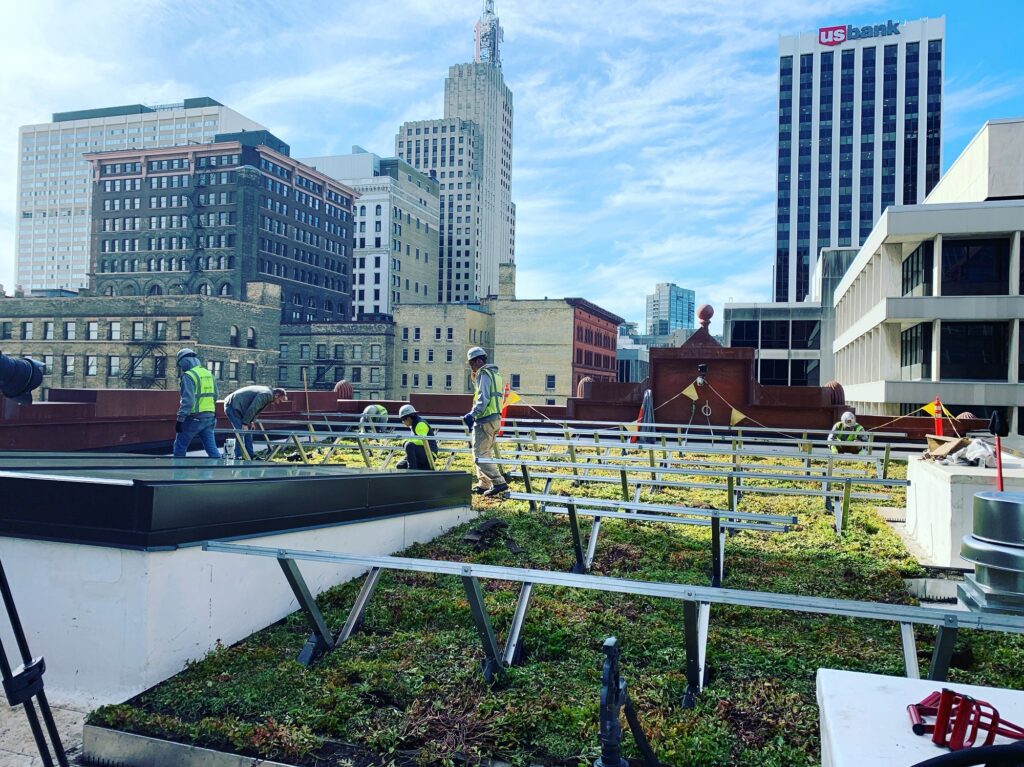
What is a biosolar roof?
Biosolar or “green” roofs and solar paneled rooftops are often thought of as separate—even competing—environmental solutions. However, the practice of combining the two technologies has become increasingly popular all over the world. The collaboration, commonly referred to as biosolar roofs, is helping to create more efficient cities and delivering widespread social, economic, and environmental advantages.
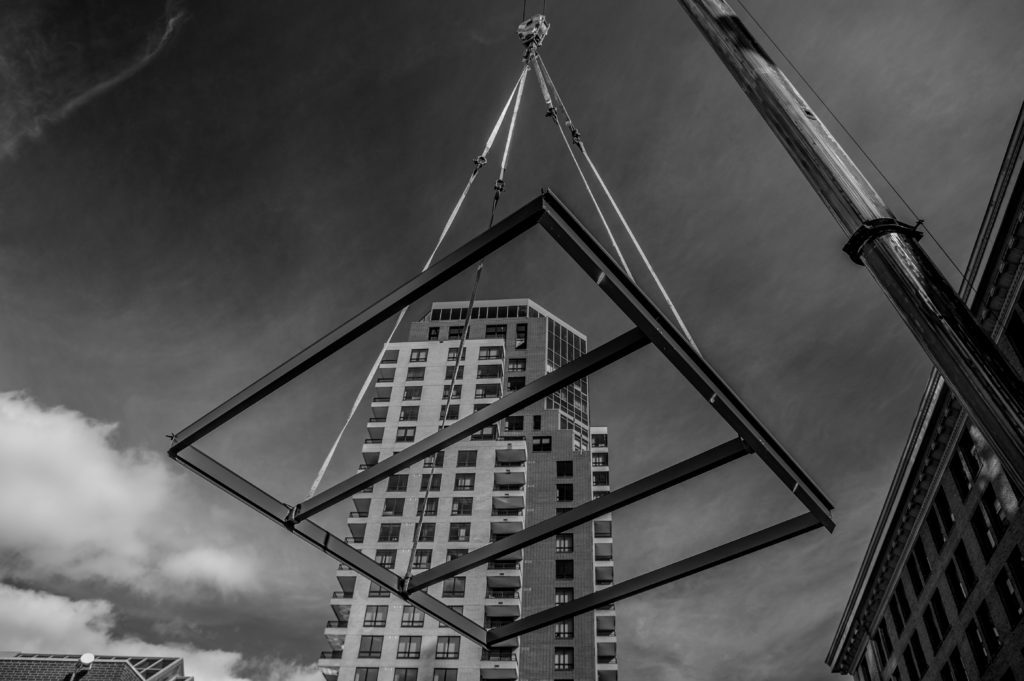
Why is a biosolar roof important?
In a warming climate, we urgently need technology that addresses and adapts to climate change with a multipronged approach that not only protects our water resources but also provides other environmental services, such as the production of onsite renewable clean energy. Additionally, it is critical that we demonstrate transparently by measuring and quantifying the benefits of green infrastructure coupled with complementary technologies, like solar photovoltaic. For this reason, we are metering and monitoring the effects of the green roof on stormwater management, urban heat island reduction and solar photovoltaic efficiency. This project was the first of its kind for the region and it could not come sooner. There is a solar boom in our region and people need to know that they can layer in green infrastructure to address water quality and quantity as well–and affordably!
What are the benefits of a green roof?
A green roof is one that either partially or fully integrates vegetation into the design. Depending on the region and climate of the building, a wide variety of different plant life can be incorporated. There are a number of benefits to ditching traditional un-vegetated gravel roofs in favor of greener ones.
- Reduced heating and cooling costs — The plants and soil of a green roof act as a natural insulator, which helps reduce internal temperature fluctuations.
- Less stormwater runoff — As the green roof plants soak up the rain, they reduce the risk of flooding and protect downstream waterbodies, like the nearby Mississippi River, from stormwater pollution. Green roofs are particularly valuable in highly urbanized city centers where an abundance of hard surfaces creates excess runoff, but space to manage that runoff is limited.
- A longer lasting roof — Most commercial roofs need to be replaced every 15-20 years due to their exposure to extreme weather conditions, but that lifespan gets vastly increased with a sheltering layer of protective plants.
- Tax breaks — Many municipalities are now providing tax benefits for property managers who construct or retrofit their buildings with environmentally friendly vegetative roofs.
- Cleaner air — The plants absorbs pollutants and greenhouse gases such as carbon dioxide, while simultaneously increasing oxygen levels.
- More plant and animal habitats — In areas with a growing number of green roofs, there is an increase in bird, insect, and other wildlife populations, as well as plant pollinations.
- Aesthetic advantages — Green roofs are visually pleasing and create a calm, colorful, and peaceful oasis in an otherwise drab and busy cityscape.
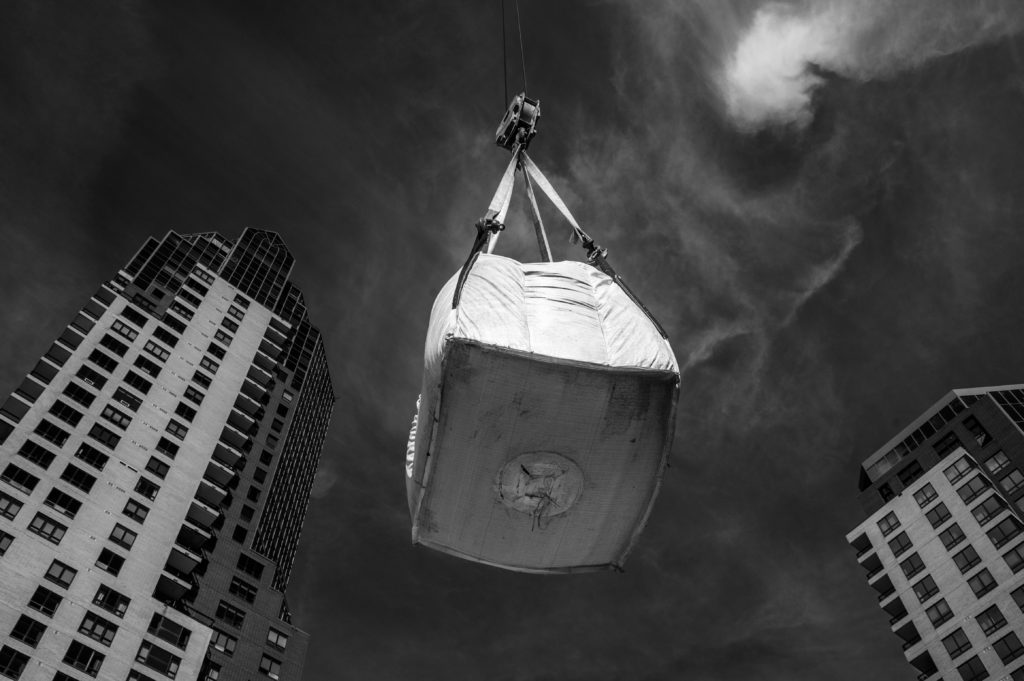
What are the benefits of solar energy?
In essence, solar panels utilize transparent glass and photovoltaic cells to convert the raw thermal energy of the sun into electricity. Solar power is one of the most popular forms of renewable energy, and there are a whole host of benefits of installing solar panels on commercial rooftops.
- Reduced electricity costs — Depending on the number of panels and the company’s electrical needs, solar rooftops are able to partially or completely power their respective buildings.
- Increased profit — Many solar-powered buildings produce more energy than they need and are able to sell any additional electricity back to the grid, easily making back their initial investments in the process.
- Zero emissions — Solar power doesn’t produce any greenhouse gases or water pollutants, making it one of the cleanest forms of renewable energy on the market.
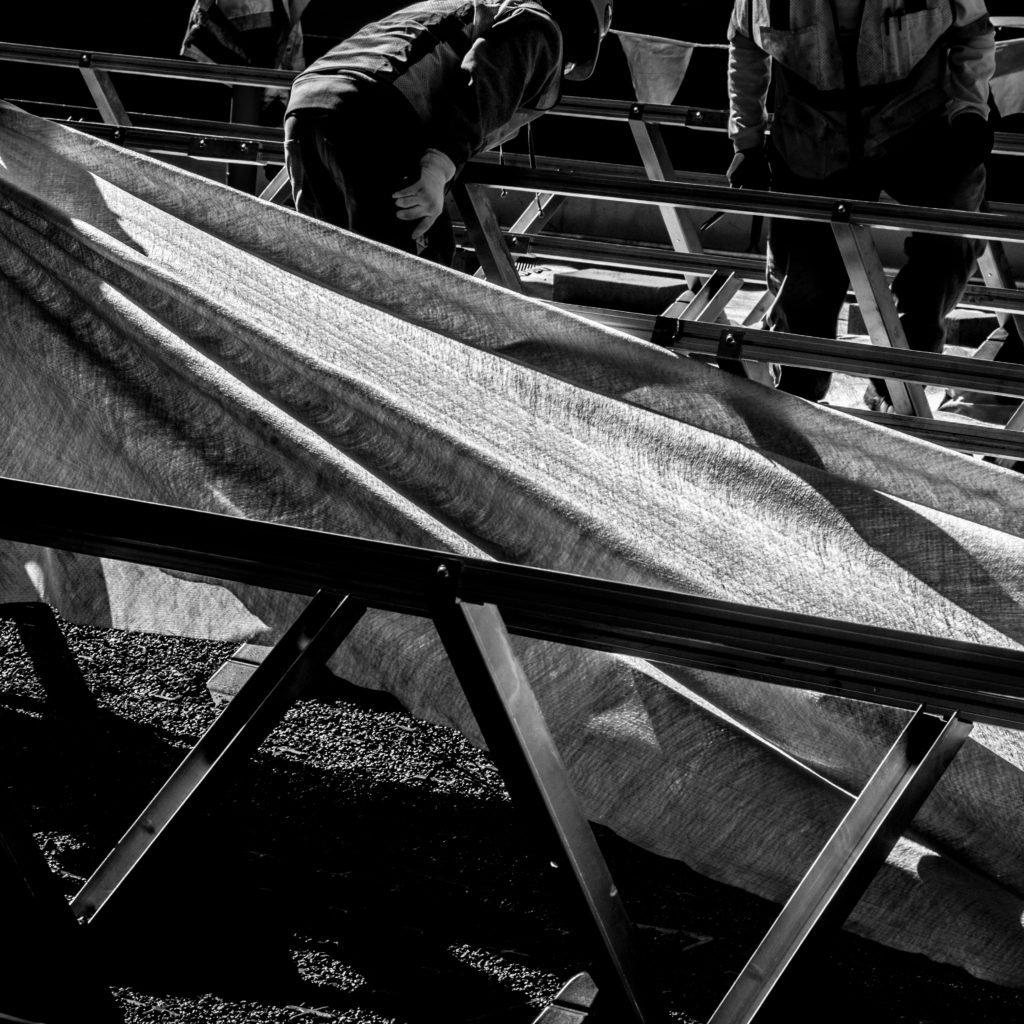
How do the two work together?
By bringing together the water-storing, habitat producing benefits of green roofs with the energy-generating capabilities of solar panels, biosolar roofs are laying down the building blocks for the future health of urban environments the world over. Studies have shown that green roofs actually increase the amount of solar energy gained from rooftop panels. On long, sunny days, photovoltaic panels can actually become too hot and begin to decrease in efficiency. The nearby vegetation helps keep the rooftop micro-climate closer to the ideal temperature for maximum solar energy production.
The specific design of the biosolar roofs, however, is incredibly important for success. If the solar element takes precedence and the panels are placed too close together, it will only stifle the growth of the plants or produce undesirable weeds. It’s paramount that a healthy balance between the two systems is achieved.
When positioned correctly, the solar panels effectively create three distinct micro-habitats, greatly increasing the biodiversity potential. Many plants thrive in the more open, sunny spaces, while others grow best under the cool shade of the solar panels. Still a third group prefers the wetter soil found at the base of the panels where the rain runoff collects the most.
Our Research: FAQs & Findings
As a Biosolar roof is the integration of green roof and solar technologies that are not usually commingled, we were interested in understanding how the two technologies would affect each other. With funding from the Capitol Region Watershed District (CRWD), we used monitoring equipment and scientific observations to answer the following questions:
Question 1: How does stormwater management on a Biosolar roof compare to a conventional green roof?
Biosolar is green infrastructure. Green infrastructure is an approach to water management that protects, restores, or mimics the natural water cycle. Green infrastructure is effective, economical, and enhances community safety and quality of life, especially as we adapt to climate change. In this case, it means planting a roof with low maintenance vegetation rather than laying a petrochemical-derived roof and building costly grey infrastructure downstream, such as sewer pipes and water treatment facilities.
The integration of the sustainable stormwater management involves employing innovative strategies to reduce runoff volumes in conjunction with associated pollution caused by stormwater. Impervious areas like conventional rooftops are designed to have stormwater immediately flow offsite during a rain event, contributing to peak discharge volumes into the Mississippi River. Like many buildings downtown, the Guardian is a zero lot line building with its footprint taking up 100% of its site. This makes it nearly impossible to manage rainwater onsite without a green roof or costly grey infrastructure.
The primary function of a green roof is hydrological—it slows stormwater runoff, reduces peak discharge, and provides evapotranspiration. The Guardian roof is designed for optimum water holding capacity within the weight bearing limits of the roof. The biosolar system is designed to manage 2 inches of rainwater collected over a 24-hour period, which is the equivalent of about 5,000 gallons. With this innovative and cost-effective best management practice (BMP), the site’s annual runoff volume will be reduced by approximately 45%, and 96% of its total suspended solids (TSS) pollution will be removed

Findings: Solar panels do not appear to limit the water retention of green roofs.
Funding from the Capitol Region Watershed District enabled a weather station and in situ (field) instruments to monitor rain events and subsequent stormwater runoff to determine how much water is actually collected during rainfall events on the biosolar roof. According to the research station, the green roof has been capturing and retaining (storing) 80-95% of rainfall during a moderate summer rainfall event of 0.3 inches of rain per hour. This is important because the vast majority of water is retained within the biosolar roof instead of flowing to storm sewers and the Mississippi River. Biosolar roofs perform similar to conventional green roofs, which means that overall, solar panels do not appear to limit the water retention of green roofs.

Chart 1 compares the water content of the green roof during the year in areas underneath the solar panels with areas lacking solar panels. This is important because there is little data on how solar panels affect stormwater management within a biosolar roof system. As the chart reveals, areas under the solar panels remain drier than areas lacking solar panels due to the fact that the solar panels limit rainwater on the green roof. However, the water content is higher under solar panels likely as a result of its shade and protection.
As expected, the green roof areas without panels retain more rainwater immediately but will also dry out quicker due to solar radiation (the sun), evapotranspiration, and other elements, like wind. Because biosolar is a new technology integrating solar and green roofs together, much is unknown about its system performance. Understanding the effect that solar panels have on a green roof system’s ability to manage water is important to future designs improvements and maintenance plans. It doesn’t appear to have a significant effect on performance.
Question 2: How would Urban Heat Island effect be impacted on a Biosolar roof?
When we introduce a vegetated green roof into the urban landscape, there is a heat reduction due to the cooling nature of plants thanks to evapotranspiration. Evapotranspiration includes the evaporation of water from soil and transpiration—the process by which plants absorb water through their roots and release it as vapor through their leaves. Both of these liquid-to-gas processes use heat from the surroundings and thus cool the air. Peer reviewed studies show green roofs temperatures are close to ambient air temperatures, compared to black membrane roofs. However, the Guardian installed a light colored roof membrane so the urban heat island is mitigated by the green roof and the exposed membrane.
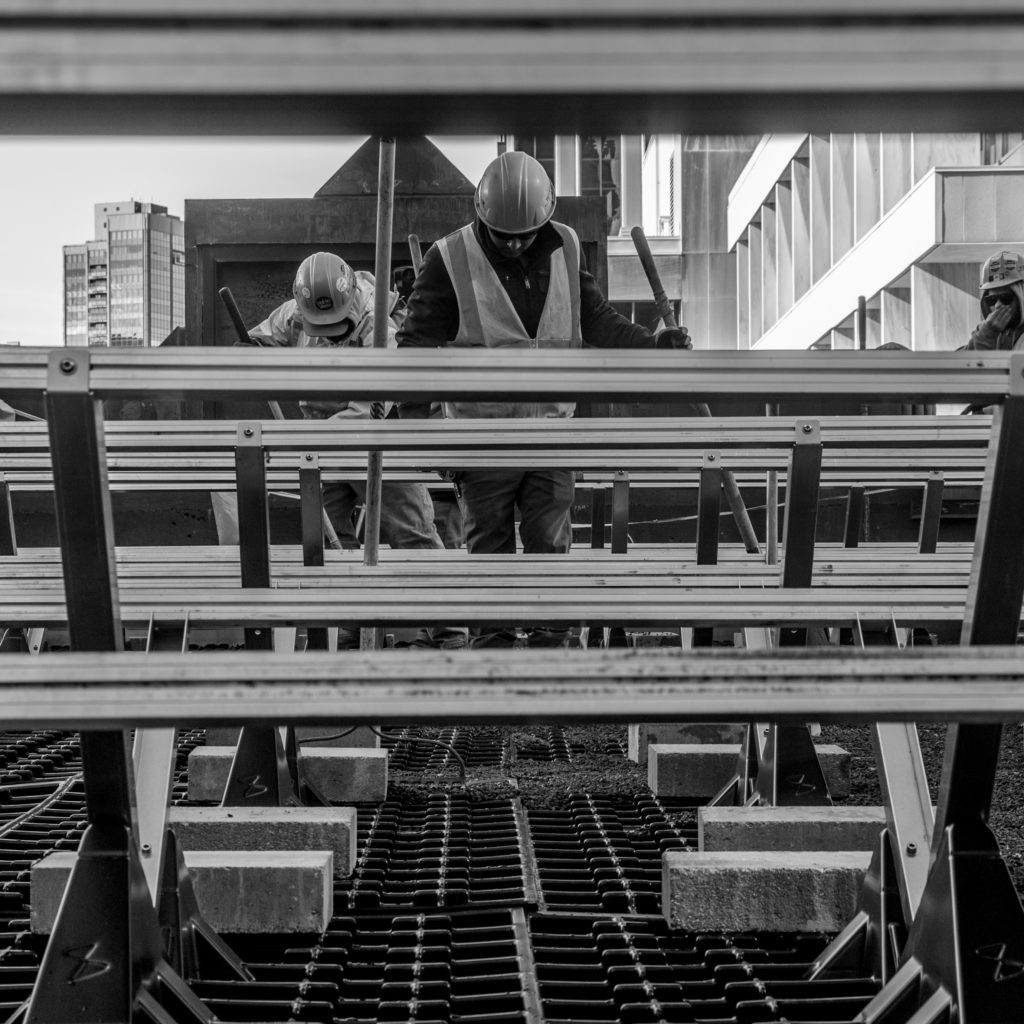
Findings: Like a conventional green roof, the temperature of the air above the biosolar roof is consistently below the ambient air temperature which likely improves solar panel performance.
As you can see in Chart 2, the air above the biosolar roof (green line) is consistently lower than the ambient roof temperature (grey line). The white roof membrane (yellow line) also is consistently cooler than the ambient air temperature. As solar panels operate more efficiently at a lower temperature, it is reasonable to assume that solar panel will operate more efficiently on a biosolar roof.

Question 3: How would vegetation and animals respond to a biosolar roof?
Most solar arrays on rooftops are ballasted with gravel, whereas the Guardian roof is covered with vegetation. In addition to managing stormwater, plants were selected that benefit pollinators. Biosolar roofs can have a direct positive impact for pollinators and a variety of bees, butterflies, and other insects have been observed on the roof since the installation.
Findings: Vegetation and pollinators appear to respond well to the biosolar roof.
We have observed that plants continue to live under the shade of the panels. However, those in the middle of the panels are flowering less and their vegetation is a bit “leggy” and are less dense, probably a result of the plants attempting to seek more light. Certain species appear to prefer the shade and are flourishing under the panels. As we are only observing its first growing season, the spaces may evolve into microclimate with distinct species and conditions. There still appears to be a lot of pollinator activity, regardless of the panels.
Question 4: How would the integration of green roof and solar installers work with a biosolar roof?
Green roofs and solar photovoltaic system installers come from very different disciplines. While both industries work on rooftops their technologies are fundamentally different. They both share concerns related to issues such as a roof’s weight-bearing capacity,protection of roof membranes from leaks and working around constraints typical of rooftops such as HVAC equipment. How would they integrate disciplines?
Findings: There were many lessons learned from the integration of solar photovoltaic panels into a green roof in the biosolar demonstration project.
1.) Establish a common language. While green roof and solar industry professionals focus on many similar aspects (shade from other buildings, lack of open space, structural limits, access to the roof and water for irrigation and repairs, etc.), vetting existing rooftops is an important first step for both industries. However the language they use is different. Green roofs are sized by square feet, soil depths, and plant palettes, and general American standard units are applied. Solar installers consider energy production and connection to the building’s electricity panel and grid. So conversations between solar and green roof professionals can be tricky during design as green roof professionals refer to horticultural terms while solar speaks in kilowatts (metric units). It is important that both industries explain their technologies to the other to avoid confusion, unit conversion errors, and miscommunication.
2.) Emphasize design and preconstruction coordination. It is imperative that integrated design occur early on in the design process. It is essential that a preconstruction meeting occurs with the design team, general contractor, trades, and product suppliers to keep the project on budget and time.
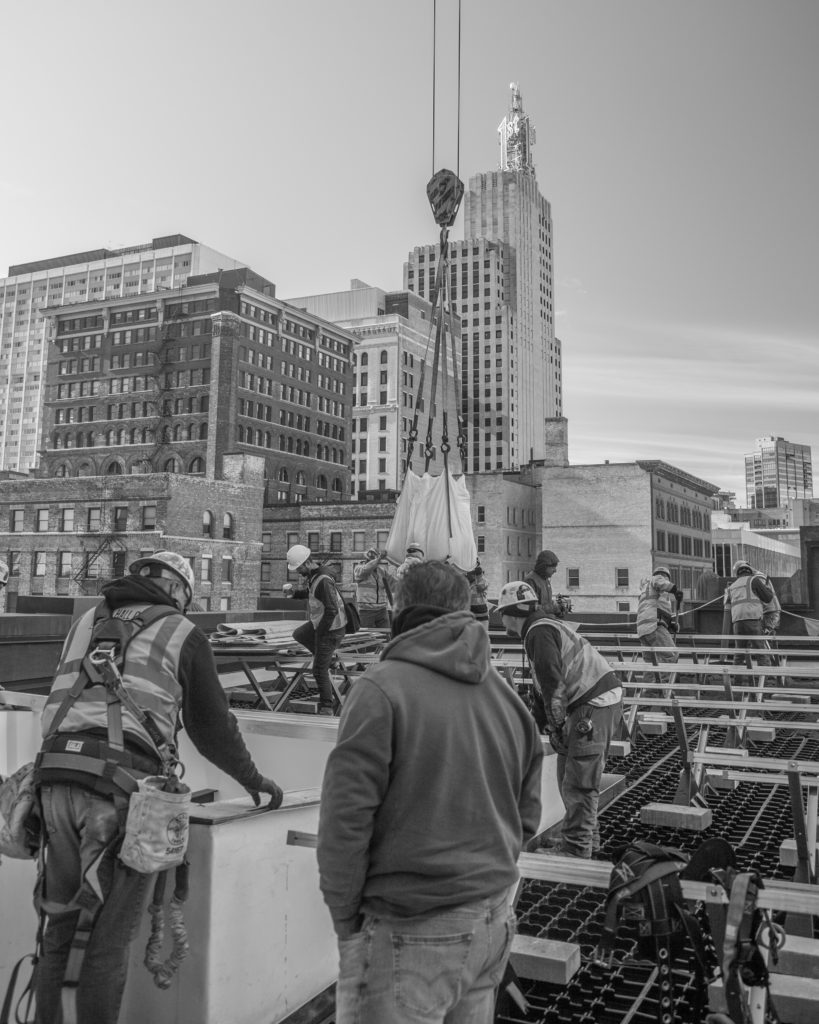
For example, after the initial biosolar design was proposed, the structural load information changed. This caused an important redesign and sourcing of the growing media that would ballast the panels for St. Paul, Minnesota conditions. Once materials were ordered, there was confusion as to what trade would be installing the rails and what the proper tools to do so were. The rails for the panels are connected to the drainage system, so it was a valid request.
Another major decision on the Guardian biosolar project was to have the green roof assembly fully planted before installing the panels. Foot traffic from the panel installation caused some damage to the vegetation. Future projects will need to budget to have extra plant material replacement.
3.) Carefully plan installation timing and integration.
Oftentimes, green roofs are the last thing installed on a project. But in the case of the biosolar project, aspects of the green roof needed to be installed prior to the solar panel assembly. In the case of the Guardian biosolar roof, we had to integrate the installation in a careful sequence after the new roof inspection was completed. The landscaper was responsible for installing the protection fabric, drain panels, filling them with ballast aggregate, covering with filter fabric, and craning up the growing media in super sacks making sure the depth was accurate, so the system wasn’t heavier than designed. The final step was to coordinate the living plant delivery with the trades. This process took about 3 weeks off and on. The panels were then installed after the landscapers completed their work. The roof construction was captured by a videographer and web cam. Maintenance is ongoing.